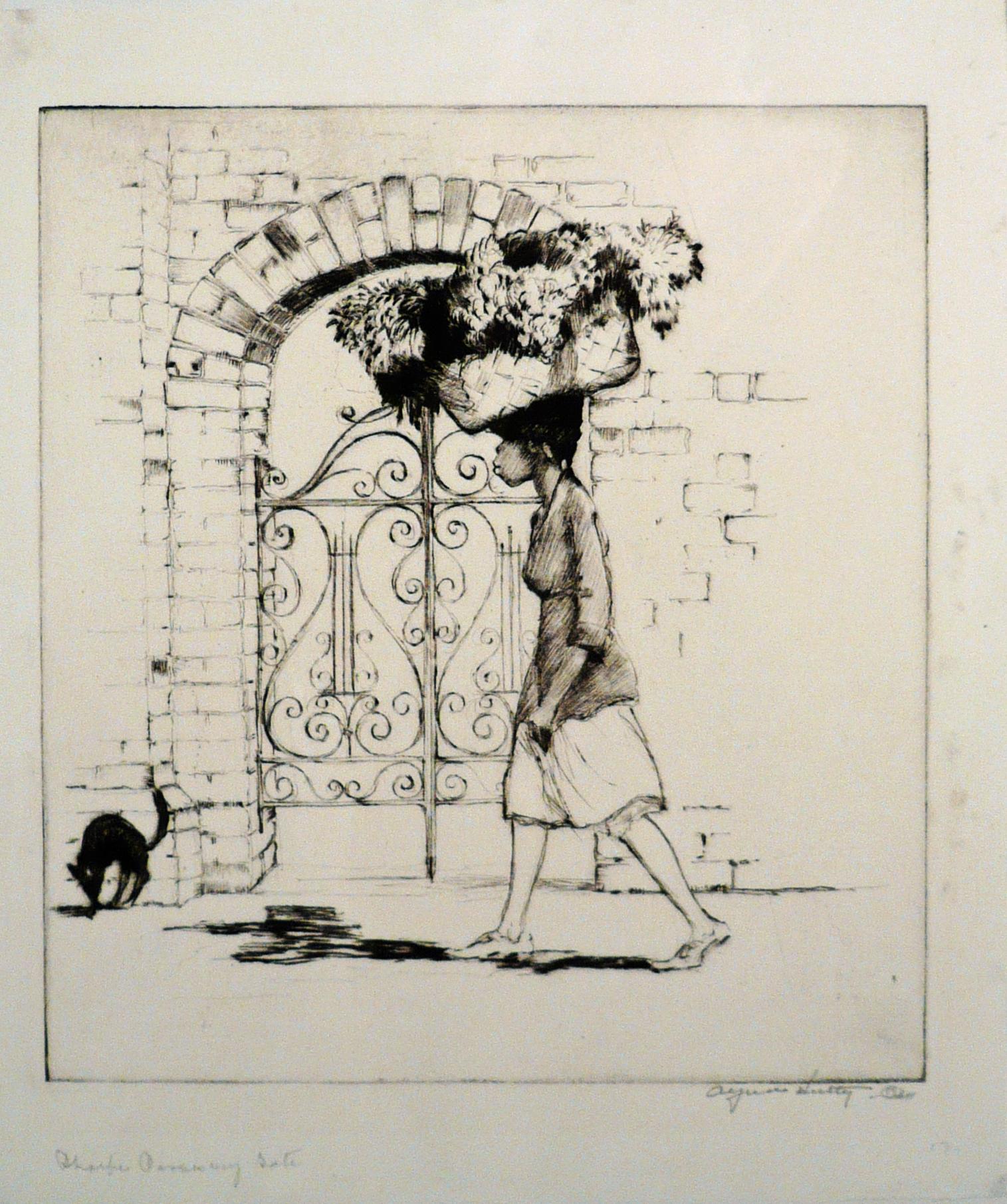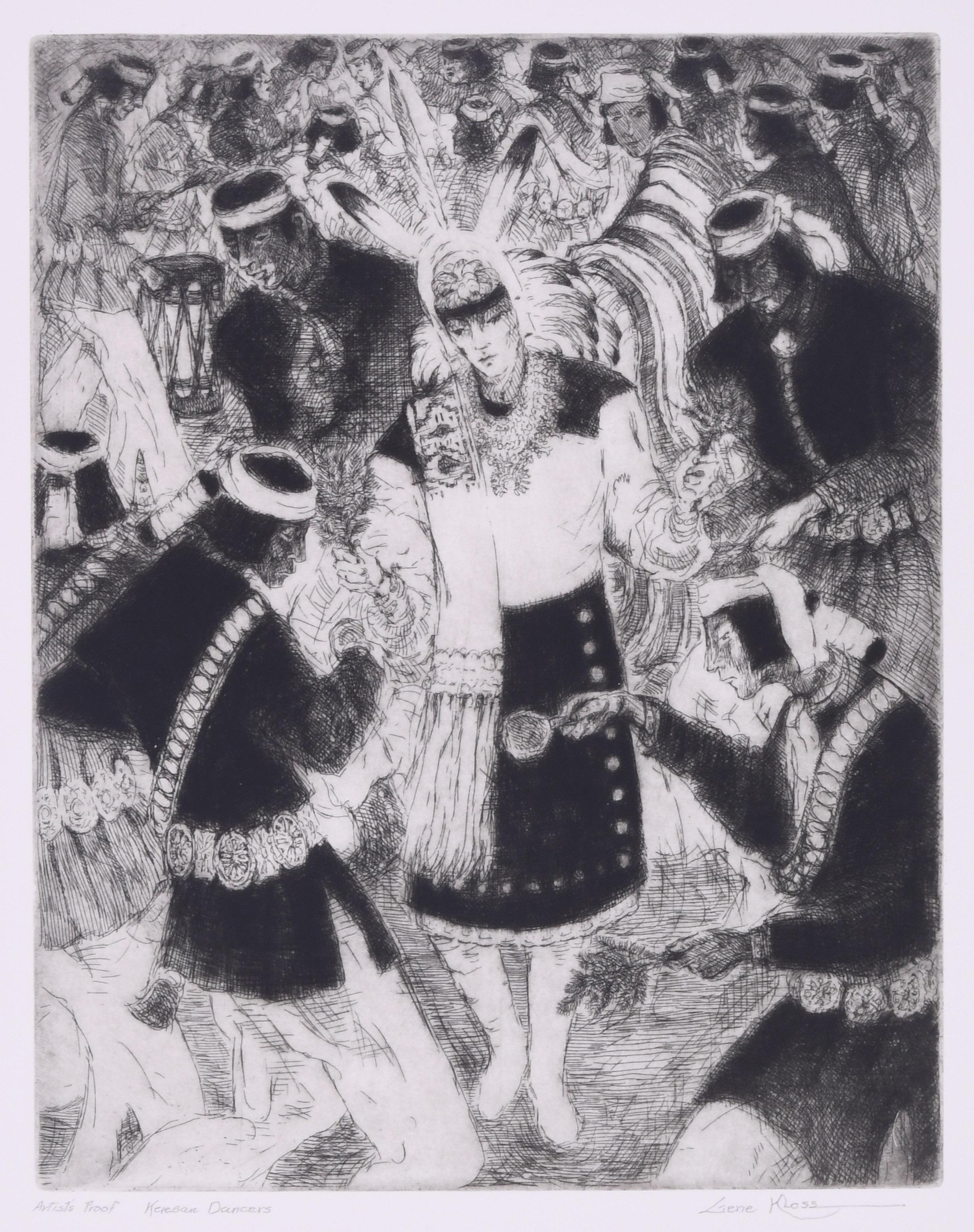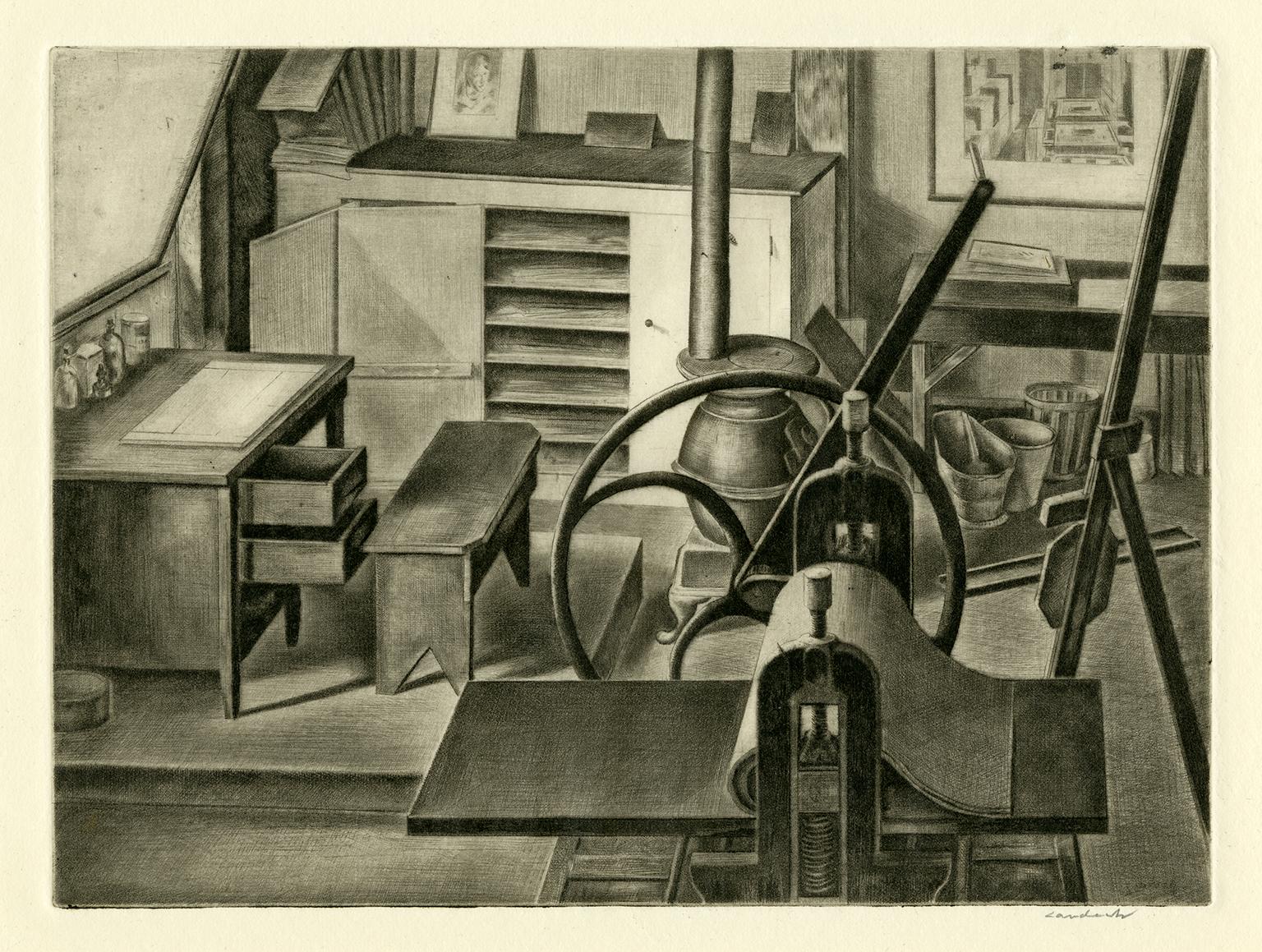Louis Conrad RosenbergBowling Green, New York1940
1940
About the Item
- Creator:Louis Conrad Rosenberg (1890 - 1983, American)
- Creation Year:1940
- Dimensions:Height: 12.94 in (32.87 cm)Width: 10.18 in (25.86 cm)
- Medium:
- Movement & Style:
- Period:
- Condition:
- Gallery Location:Myrtle Beach, SC
- Reference Number:
Louis Conrad Rosenberg
Architect and printmaker, Louis Conrad Rosenberg was born in Portland, Oregon. The recipient of a scholarship awarded by the Architectural Club of Portland, Rosenberg attended the Massachusetts Institute of Technology. Graduating in 1914, Rosenberg was granted a traveling fellowship in architecture and after the war he traveled throughout England, Europe, the Near East and Northern Africa, creating thousands of sketches. Rosenberg began his first experiments in etching while studying at the American Academy in Rome, in 1921, and has given an exhibition there. His prints came to the attention of Muirhead Bone, who looked him up during a visit to New York and suggested that he pursue etching more seriously. Soon after that meeting, Rosenberg entered the school of engraving at the Royal College of Art in London, making 20 distinguished plates in a year and launching his career as a printmaker. On his return to the United States, he took up a teaching position in architectural design at the University of Oregon. Etching for the American Etchers Series, he was commissioned to render the existing sites, new structures and demolitions of the Cleveland Railroad Terminal. In 1930, Rosenberg undertook a similar commission for the Cincinnati Union Terminal that produced some of his finest work. In 1946, he joined the New York architectural firm of Sawyer and York and remained there until retiring. Widely respected for his impeccable drypoint technique, flawless composition and sensitive architectural renderings, Rosenberg was the recipient of many medals and awards. He was an emeritus member of the American Institute of Design and senior fellow in the Royal Society of Painters, Etchers and Engravers. Rosenberg was also a member of the Brooklyn Society of Etchers, Chicago Society of Etchers, Philadelphia Society of Etchers and Engravers Associates and the Chelsea Arts Club, London. Rosenberg received a silver medal from the Printmakers Society of California, 1924.
- ShippingRetrieving quote...Ships From: Myrtle Beach, SC
- Return PolicyA return for this item may be initiated within 7 days of delivery.
- 'Tree, Manhattan' — Classic American RealismBy Martin LewisLocated in Myrtle Beach, SCMartin Lewis, 'Tree, Manhattan', drypoint, 1930, edition 91 (including 10 trial proofs), McCarron 87. Signed in pencil. A superb, atmospheric impression, in warm black ink, on cream...Category
1930s American Realist Figurative Prints
MaterialsDrypoint
- Studio Interior No. 1 — 1930s MasterworkBy Armin LandeckLocated in Myrtle Beach, SCArmin Landeck, 'Studio Interior No. 1', 1935, drypoint, edition 100, Kraeft 56. Signed in pencil. Signed in the plate, lower right. A fine, richly-inked impression, on cream laid pap...Category
1930s American Realist Figurative Prints
MaterialsDrypoint
- Mosque of the Sultan Bayazid, ConstantinopleBy Louis Conrad RosenbergLocated in Myrtle Beach, SCLouis Conrad Rosenberg, 'Mosque of the Sultan Bayazid, Constantinople', etching, 1927. Signed in pencil. Initialed and dated in the plate, lower left. A fine, richly-inked impression...Category
1920s American Realist Figurative Prints
MaterialsDrypoint
- 'Cargo Carriers' — 1930s New York HarborBy Otto KuhlerLocated in Myrtle Beach, SCOtto Kuhler, 'Cargo Carriers', etching and drypoint, c. 1932, edition 10, Kennedy 44. Signed in pencil. A superb, atmospheric impression with rich burr and selectively wiped overall plate tone, in dark brown ink, on Arches cream laid paper; wide margins (2 to 2 3/4 inches), in very good condition. Printed by the artist. Original Kennedy Galleries mat and label. Scarce. "On my trips up and down N.Y. harbor on the Weehawken Ferry, the late evening sun playing on the side of the big liners has always intrigued me... The liner shown I believe to be the Vaterland of the North German Lloyd...Category
1930s American Modern Figurative Prints
MaterialsEtching, Drypoint
- 'Fantasia Americana - 1880' — Mid-Century American SurrealismBy Lawrence KupfermanLocated in Myrtle Beach, SCLawrence Kupferman, 'Fantasia Americana – 1880', drypoint etching with sandground, 1943. Signed, titled, and annotated 'Series A, 1971 2/6' in pencil. A superb, richly-inked impression, on heavy, cream wove paper, with full margins (2 1/2 to 3 1/2 inches); the paper slightly lightened within the original mat opening, otherwise in excellent condition. One of only 6 impressions printed in 1971, with the added sandground grey background tint. Image size 11 13/16 x 14 3/4 inches; sheet size 18 x 20 1/4 inches. Archivally matted to museum standards, unframed. Collections: National Gallery of Art, Zimmerli Art Museum (Rutgers University). ABOUT THE ARTIST Lawrence Kupferman (1909 - 1982) was born in the Dorchester neighborhood of Boston and grew up in a working-class family. He attended the Boston Latin School and participated in the high school art program at the Museum of Fine Arts, Boston. In the late 1920s, he studied drawing under Philip Leslie Hale at the Museum School—an experience he called 'stultifying and repressive'. In 1932 he transferred to the Massachusetts College of Art, where he first met his wife, the artist Ruth Cobb. He returned briefly to the Museum School in 1946 to study with the influential expressionist German-American painter Karl Zerbe. Kupferman held various jobs while pursuing his artistic career, including two years as a security guard at the Museum of Fine Arts, Boston. During the 1930s he worked as a drypoint etcher for the Federal Art Project, creating architectural drawings in a formally realistic style—these works are held in the collections of the Fogg Museum and the Smithsonian American Art Museum. In the 1940s he began incorporating more expressionistic forms into his paintings as he became progressively more concerned with abstraction. In 1946 he began spending summers in Provincetown, Massachusetts, where he met and was influenced by Mark Rothko, Hans Hofmann, Jackson Pollock, and other abstract painters. At about the same time he began exhibiting his work at the Boris Mirski Gallery in Boston. In 1948, Kupferman was at the center of a controversy involving hundreds of Boston-area artists. In February of that year, the Boston Institute of Modern Art issued a manifesto titled 'Modern Art and the American Public' decrying 'the excesses of modern art,' and announced that it was changing its name to the Institute of Contemporary Art (ICA). The poorly conceived statement, intended to distinguish Boston's art scene from that of New York, was widely perceived as an attack on modernism. In protest, Boston artists such as Karl Zerbe, Jack Levine, and David Aronson formed the 'Modern Artists Group' and organized a mass meeting. On March 21, 300 artists, students, and other supporters met at the Old South Meeting House and demanded that the ICA retract its statement. Kupferman chaired the meeting and read this statement to the press: “The recent manifesto of the Institute is a fatuous declaration which misinforms and misleads the public concerning the integrity and intention of the modern artist. By arrogating to itself the privilege of telling the artists what art should be, the Institute runs counter to the original purposes of this organization whose function was to encourage and to assimilate contemporary innovation.” The other speakers were Karl Knaths...Category
1940s Surrealist Figurative Prints
MaterialsDrypoint, Etching
- 'Grand Central Station' — 1920s New York CityBy Otto KuhlerLocated in Myrtle Beach, SCOtto Kuhler, 'Grand Central Station', etching and drypoint, 1927, edition c. 50, Kennedy 27. Signed and titled in pencil. A superb, richly-inked impression, in brown/black ink, with ...Category
1920s American Impressionist Figurative Prints
MaterialsDrypoint, Etching
- PHOEBE PASSES MY GATELocated in Portland, MEHutty, Alfred. PHOEBE PASSES MY GATE. Drypoint, c. 1931. Edition size c.75. 8 1/8 x 7 1/4 inches (plate), 10 1/4 x 8 3/4 inches (sheet). Printed on laid paper. In excellent condit...Category
1930s American Realist Figurative Prints
MaterialsDrypoint
- Keresan DancersBy Gene KlossLocated in Fairlawn, OHKeresan Dancers Etching & drypoint, 1962 Signed lower right (see photo) Inscribed lower left: "Artist's Proof Keresan Dancers" Depicts Keresan speaking peoples at Sam Felipe Pue...Category
1960s American Realist Figurative Prints
MaterialsDrypoint
- Winter Tracery (Milford Connecticut)Located in San Francisco, CAThis artwork titled 'Winter Tracery (Milford Connecticut)" is an original drypoint etching by noted American artist Philip Kappel, 1901-1981. It is hand signed and titled in pencil by the artist. The plate mark (Image) size is 9 x 12 inches, framed size is 17.25 x 21.25 inches. Custom framed in a wooden light grey frame, with light grey matting and black color fillet. It is in excellent condition. About the artist: Philip Kappel — painter, illustrator, printer, writer, and lecturer — was born on February 10, 1901 in Hartford, CT and died in 1981. Kappel is best remembered for his landscapes, portraits, figures, marine, lithography, and etching. He held a teaching position with H. B. Snell, Boothbay, ME Studios, 1923 and 1924. His addresses in 1929 were 500 Fifth Avenue in New York City and, for the summer, care of Philip Little, 10 Chestnut Street, Salem, MA; and in 1935, Sarasota, FL. Kappel was a pupil of the Pratt Institute Art School in Brooklyn, NY and Philip Little (1857-1942) and held memberships with the North Shore Artists Association in Gloucester, MA; the Marblehead...Category
Mid-20th Century American Realist Figurative Prints
MaterialsDrypoint, Etching
- The Bridge PartyBy Peggy BaconLocated in New York, NYPeggy Bacon drypoint The Bridge Party, signed, dated (Nov. 1918) and titled (Bridge) in pencil by the artist. Flint 3. In generally ok but rough condition as befits an early working ...Category
1910s American Realist Figurative Prints
MaterialsDrypoint
- At the ShowBy Jerome MyersLocated in New York, NYJerome Myers (1867-1940), At the Show, etching and drypoint, c. 1920, signed in pencil lower right. In good condition, with margins (paper losses upper corners), faint ink marks and ...Category
1920s American Realist Figurative Prints
MaterialsDrypoint, Etching
- HEAD OF A WOMAN IN PROFILEBy Julian Alden WeirLocated in Santa Monica, CAJ. ALDEN WEIR (1852 – 1919) LARGE HEAD IN PROFILE, 1891 (Zimmerman 30) Signed and dated in plate only in upper left corner. 7 7/8 x 5 7/8” Sheet size 13 x 9 ¼”. Delicate impressi...Category
1890s American Realist Figurative Prints
MaterialsDrypoint





